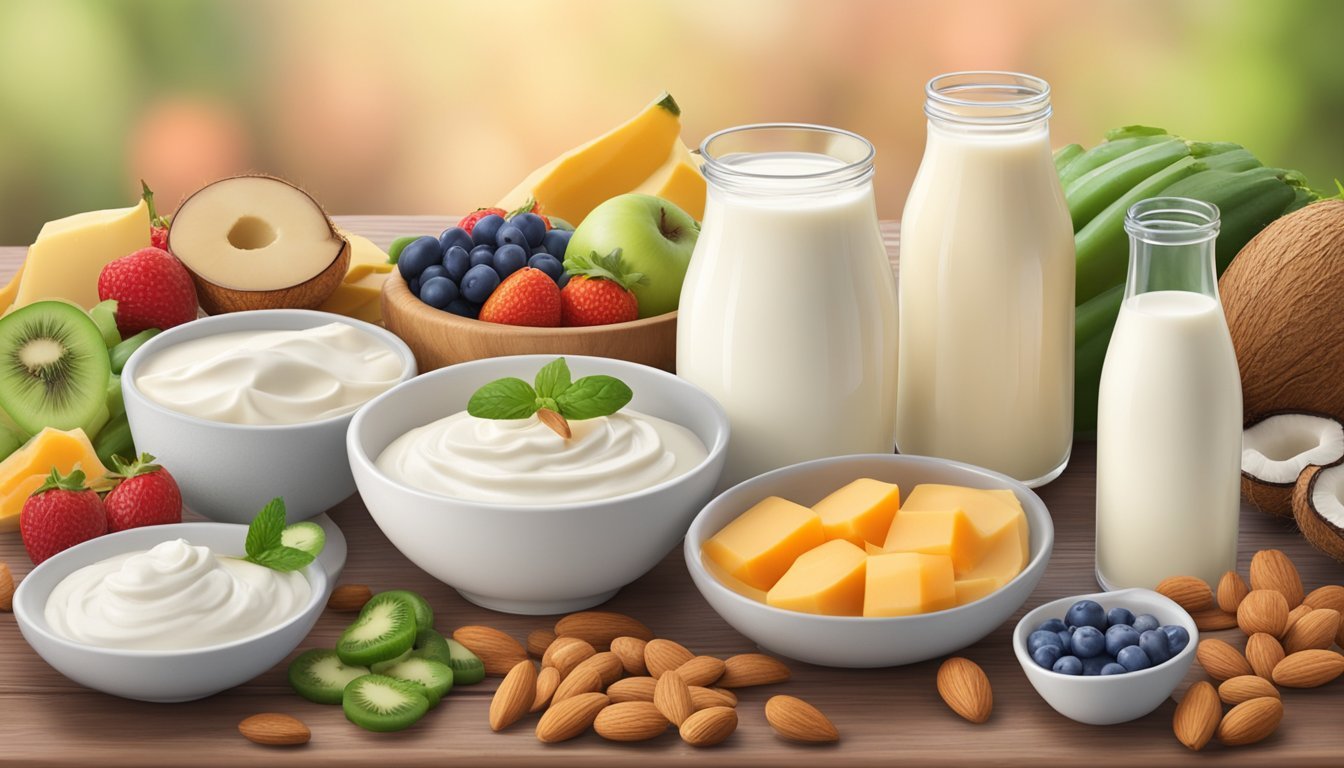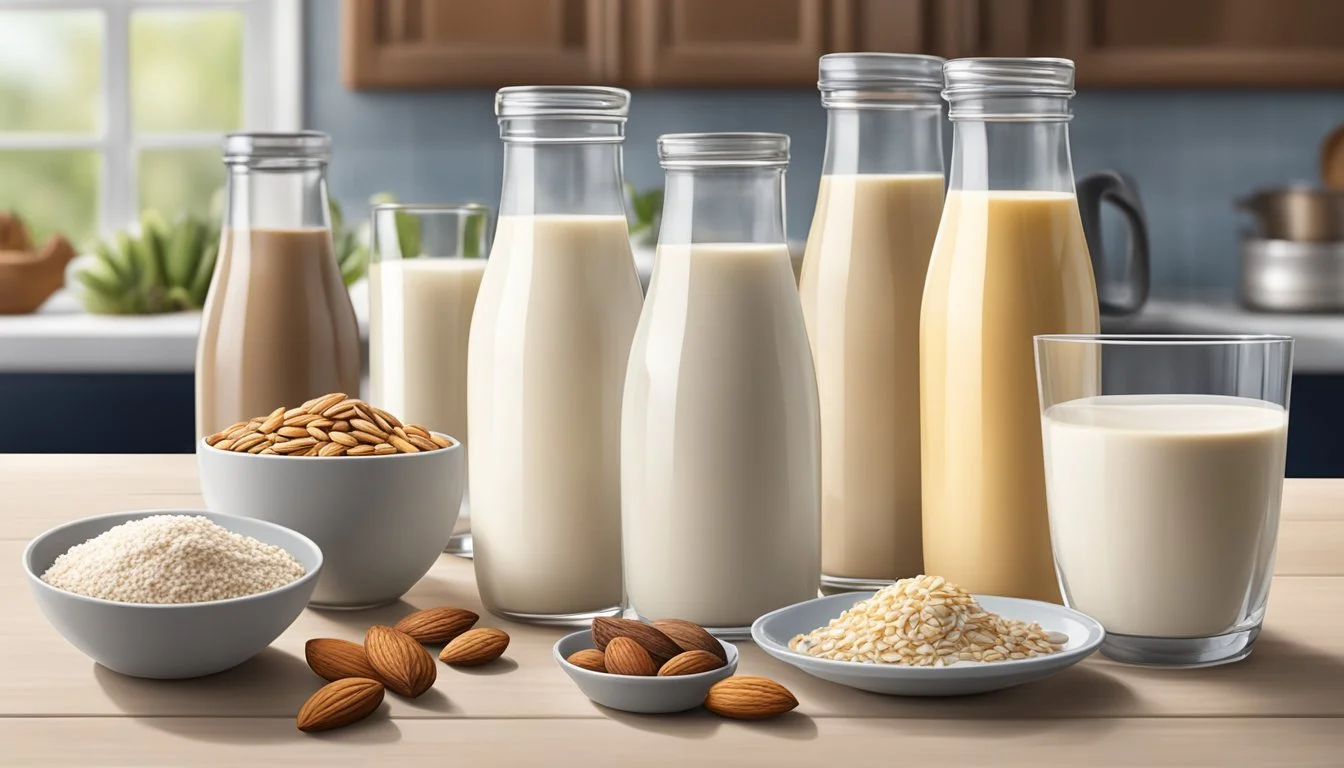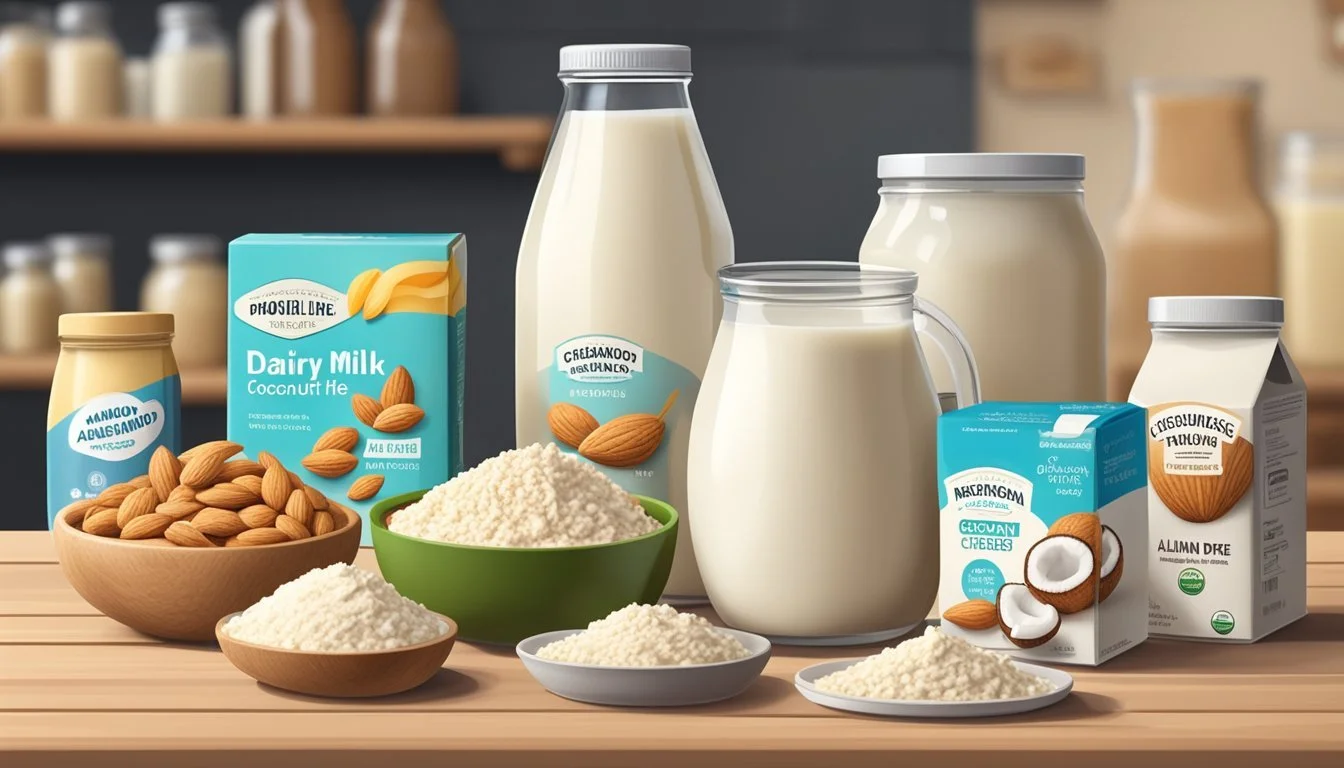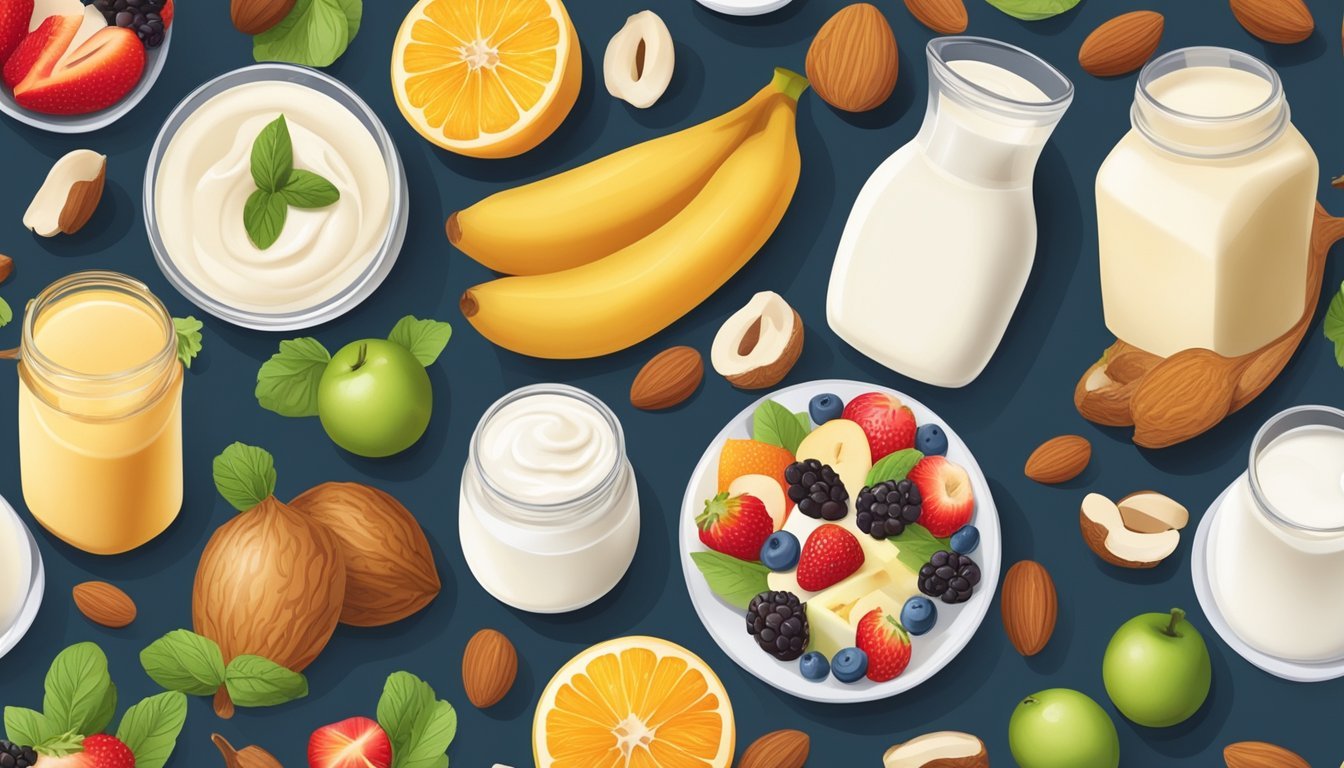The Best Dairy Substitutes for a Grain-Free Diet
Optimal Choices for Health and Flavor
Individuals who follow a grain-free diet often eliminate not only grains but sometimes dairy as well, either due to dietary restrictions, allergies, or personal health choices. Fortunately, the market for nondairy substitutes has expanded greatly, offering a wide array of alternatives that cater to these dietary needs without compromising on taste or nutritional value. These dairy-free alternatives are designed to be integrated seamlessly into daily diets, providing essential nutrients typically found in traditional dairy products.
When considering a dairy-free diet, it’s important to evaluate the nutritional content of substitutes to ensure they provide an adequate replacement for the benefits dairy offers. Options such as unsweetened soy milk are rich in protein and can be a good alternative for cow's milk in various recipes. Almond milk and coconut milk, though lower in protein, can be fortified with vitamins and minerals, making them excellent alternatives for those who also avoid grains.
Selecting the best dairy substitutes involves balancing flavor preferences with nutritional needs and cooking requirements. Rice milk, for instance, with its sweeter taste and watery texture, might be better suited for cereal, while a thicker milk alternative like cashew milk might be preferred for coffee or baking. It is also important to consider potential allergens and special dietary needs, such as low-calorie or low-fat requirements, when choosing the best nondairy substitute for a grain-free diet.
When following a grain-free diet, finding the best dairy substitutes can be a delightful exploration into flavorful and nourishing options. By incorporating these substitutes, individuals can support their grain-free gut microbiota and promote digestive health, contributing to an overall sense of well-being.
Exploring the diverse offerings in the grain-free products market can provide a wealth of dairy-free alternatives, supporting grain-free meal planning and culinary creativity. Additionally, engaging with grain-free food bloggers can offer valuable insights and inspiration, providing a community of support and innovative ideas for incorporating dairy substitutes into a grain-free lifestyle.
Incorporating these substitutes can also contribute to promoting grain-free heart health, aligning with a health-conscious approach to nourishment. Whether used in savory dishes for a comforting grain-free dinner or enjoyed as wholesome grain-free snacks, these dairy substitutes offer a versatile and satisfying addition to a grain-free diet.
By embracing the best dairy substitutes, individuals can savor a diverse array of flavorful and nourishing options, supporting their dietary preferences while nurturing their overall well-being.
Understanding Dairy Substitutes
When considering a grain-free diet, understanding the options available for dairy substitutes is crucial. These alternatives should not only complement the absence of grains but also offer nutritional benefits that dairy products typically provide.
Defining Dairy Substitutes
Dairy substitutes are food products that mimic the taste, texture, and nutritional profile of dairy, designed for those who avoid animal milk due to allergies, lactose intolerance, ethical reasons, or personal health choices. They are typically sourced from plants and come in various forms including milks, cheeses, yogurts, and creams.
Benefits of Going Dairy-Free
People may choose dairy-free substitutes for a range of benefits. Dairy-free diets can lead to improvements in digestive health, particularly for those with lactose intolerance. By eliminating dairy, they can lessen symptoms like bloating and discomfort. Additionally, dairy substitutes may have added nutrients like calcium and vitamin D, making them beneficial for bone health.
Table: Nutrients Often Fortified in Dairy Substitutes
Nutrient Benefit Calcium Essential for bone health Vitamin D Helps absorb calcium and support the immune system B12 Important for nerve function and producing DNA Iron Crucial for oxygen transport in the blood
Common Dairy Components and Their Substitutes
For those on a grain-free diet, finding suitable substitutes that also address common dairy components is essential.
Milk: Non-dairy milks such as almond, coconut, and soy milk can replace cow's milk. These substitutes are often fortified with calcium and vitamin D.
Cheese: Nutritional yeast, cashew-based spreads, and soy-based cheese emulate the flavor and texture of traditional cheese, while being free from lactose.
Cream: Coconut cream and soaked, blended cashews can replicate the richness of dairy cream in recipes.
Individuals seeking dairy substitutes should read labels carefully to make sure that they meet their dietary needs and do not contain additives incompatible with a grain-free diet.
Nutritional Profile of Dairy Alternatives
Dairy alternatives vary in nutritional content, offering a range of proteins, calories, fats, and essential micronutrients necessary for a balanced diet.
Protein Content in Plant-Based Milks
Plant-based milks offer varying levels of protein. Soy milk, for instance, is comparable to cow's milk, providing about 7-9 grams of protein per cup. Most other dairy alternatives, such as almond milk or coconut milk, typically offer less protein, often around 1 gram per cup.
Calculating Calories and Fats
The calorie and fat content in dairy substitutes can differ significantly. For an understanding of their impact on a grain-free diet, consider the following:
Soy milk: 80-90 calories and 4-4.5 grams of fat per cup (unsweetened)
Rice milk: Generally higher in calories due to its natural sweetness
Almond milk: Often lower in calories and fat, depending on whether it's sweetened or fortified
Remember, the choice of unsweetened or sweetened versions will affect the overall calorie count.
Vitamins and Minerals in Dairy-Free Products
Dairy substitutes may be fortified to provide essential nutrients. They often contain:
Calcium: Fortified plant-based milks can provide a similar amount of calcium as cow's milk.
Vitamins: Including vitamin D and B12, which are important for bone health and energy metabolism.
It's important for consumers to check the labels for nutrient fortification, especially in a grain-free diet where dairy is traditionally a primary source of these nutrients.
Popular Non-Dairy Milks and Their Uses
When adopting a grain-free diet, one must carefully consider alternatives to dairy milk. The following non-dairy milks provide a range of flavors and nutritional profiles suitable for various culinary applications.
Almond Milk
Almond milk is a low-calorie substitute with a nutty flavor and a creamy texture. It is often fortified with calcium and vitamin D, making it a health-conscious choice for those avoiding dairy. Almond milk is versatile and can be used in recipes ranging from smoothies to baked goods.
Soy Milk
Soy milk is a protein-rich option that closely resembles cow's milk in both taste and nutrient content. It contains a similar amount of protein and is often used as a direct replacement in savory dishes, coffee, and cereals. Many brands of soy milk come enriched with additional nutrients like calcium and vitamin D.
Coconut Milk
Coconut milk is known for its rich, creamy consistency and slightly sweet taste. It's an excellent choice for curries and soups, as well as tropical-inspired beverages. Coconut milk typically has a higher fat content, which lends a luxuriously smooth texture to recipes.
Rice Milk
Rice milk is the most hypoallergenic of all non-dairy milks, making it an excellent option for those with multiple food sensitivities. It is relatively thin and has a naturally sweet flavor, ideal for desserts and sweet recipes. However, rice milk is lower in protein and often fortified with vitamins and minerals.
Oat Milk
Oat milk is celebrated for its fiber content and environmentally friendly footprint. It has a mild, slightly sweet flavor and a consistency that works well in coffee, smoothies, and even in making dairy-free cream soups. Oat milk is often fortified with vitamins and minerals to enhance its nutritional value.
Nut Milks Variety
Aside from almond milk, there are other nut-based milk substitutes such as cashew, hazelnut, and macadamia. Nut milks often boast a creamy texture and a rich, distinct taste. They work well in recipes as a dairy milk alternative, though their nutrient profiles can vary, and they're generally not as protein-dense. Nut milks may be fortified with nutrients like calcium and vitamin D to approximate the nutritional benefits of cow's milk.
Solid Dairy Alternatives for Cooking and Baking
When adopting a grain-free diet, one must carefully select solid dairy alternatives that cater to cooking and baking needs, ensuring they align with both taste preferences and dietary requirements. Below are suitable substitutes for cheese, yogurt, and butter or cream, crucial for anyone with dairy allergies or those following a dairy-free, vegan, or plant-based lifestyle.
Cheese Alternatives
For those
Allergies and Intolerances to Dairy
When individuals face adverse reactions to dairy, it's crucial to distinguish between an allergy and intolerance, as they affect the body differently. Knowing these can lead to making better dietary choices for health and well-being.
Identifying Dairy Allergies and Intolerance
Dairy Allergy occurs when the immune system reacts to proteins found in milk, primarily casein and whey. Symptoms can range from mild (hives, swelling) to severe (anaphylaxis). It often presents in childhood and may be outgrown, but it can persist into adulthood.
Dairy Intolerance, commonly lactose intolerance, arises from the body's inability to break down lactose due to a deficiency in the enzyme lactase. Key symptoms include:
Bloating
Gas
Discomfort
Diarrhea
Both require different diagnostic approaches:
Allergy - Skin prick tests or blood tests for IgE antibodies
Intolerance - Lactose tolerance tests or hydrogen breath tests
Effects of Dairy on Digestion and Health
Dairy's impact on digestion for those with intolerance involves a diminished ability to process lactose, leading to gastrointestinal discomfort. In contrast, an allergic response can affect multiple systems, including skin, respiratory tract, and the gastrointestinal system.
Health benefits of dairy include calcium and vitamin D for bone health; however, for people with allergies or intolerances, the risks often outweigh the benefits. Alternative sources of these nutrients must be sought to maintain dietary balance without the adverse effects associated with dairy consumption.
Dairy Substitutes in Special Diets
Individuals following special diets such as grain-free, gluten-free, vegan, or paleo lifestyles often seek dairy substitutes that align with their dietary needs. Finding suitable alternatives requires understanding the specific restrictions and nutritional profiles of each diet.
Grain-Free and Gluten-Free Options
When adhering to a grain-free diet, individuals avoid grains like wheat, barley, and oats, all of which contain gluten. Dairy alternatives suitable for a grain-free diet also usually fit within a gluten-free diet. Here are some dairy-free, grain-free, and gluten-free milk substitutes:
Almond Milk: A versatile choice that is free from dairy, grains, and gluten.
Coconut Milk: Rich in flavor and suitable for cooking, free from dairy and gluten.
Rice Milk: Although rice is a grain, rice milk is considered gluten-free. However, it may not be suitable for a strictly grain-free diet.
Individuals should always check the labels for cross-contamination if they have a high sensitivity to gluten.
Considering Vegan and Paleo Choices
The vegan diet excludes all animal products, while the paleo diet emphasizes eating foods that would have been available to Paleolithic humans, excluding dairy and grains.
For those on a vegan and paleo diet, here are some recommendations for dairy substitutes:
Cashew Milk: It's creamy like dairy milk, allowing it to work well in a variety of dishes, and it's acceptable for both vegan and paleo diets.
Hemp Milk: Hemp seeds are paleo-friendly and devoid of animal products, making hemp milk suitable for vegans and those on a paleo diet.
In conclusion, individuals pursuing grain-free, gluten-free, vegan, or paleo diets have various alternatives for dairy milk. Choosing the right substitute involves paying attention to the diet's restrictions and checking the ingredients to ensure the product aligns with their specific dietary needs.
Homemade Dairy-Free Alternatives
For individuals following a grain-free diet, creating dairy-free alternatives at home from plant-based sources offers control over ingredients and can cater to personal taste preferences. Homemade versions often leverage nuts and seeds to replicate the richness and texture of dairy products.
DIY Plant-Based Milks
Almond Milk: Often preferred for its mild flavor and creaminess, almond milk can be made by blending soaked almonds with water. The basic recipe involves:
Ingredients: 1 cup of raw almonds, 2 cups of water for soaking, 4 cups of water for blending.
Instructions: Soak almonds overnight, rinse, then blend with fresh water. Strain using a cheesecloth or a nut milk bag.
Cashew Milk: This is a naturally creamy milk alternative and does not usually require straining due to its lower fiber content.
Ingredients: 1 cup of raw cashews, 4 cups of water.
Instructions: Similar to almond milk, soak, blend, and strain if desired.
Hemp Milk: Made from hemp seeds, this milk is a great alternative for its earthy taste and rich omega fatty acids.
Ingredients: 1 cup of hemp seeds and 4 cups of water.
Instructions: No soaking needed; simply blend and strain for a smoother texture.
Creating Dairy-Free Cheese and Yogurt at Home
Cheese: A variety of nuts such as cashews can be used to create dairy-free cheeses. With the addition of nutritional yeast, lemon juice, and seasoning, one can create a spreadable or firm cheese with a tangy, savory flavor.
Ingredients for Spreadable Cheese: 1 cup of cashews, ¼ cup of nutritional yeast, lemon juice, salt, and garlic.
Instructions: Soak cashews, blend all ingredients until smooth, and refrigerate to set.
For a firmer cheese, additional steps like culturing with probiotics or setting with agar can be used.
Yogurt: Coconut milk serves as a rich base for homemade dairy-free yogurt. Using a thickening agent and probiotics can result in a creamy, tangy yogurt.
Ingredients: 1 can of full-fat coconut milk, 1-2 probiotic capsules.
Instructions: Mix the coconut milk with the contents of the probiotic capsules and ferment in a warm place for 24-48 hours.
Each ingredient should be chosen carefully, with a preference for organic and unprocessed options to maximize nutritional benefits and align with a grain-free diet philosophy.
Understanding Food Labels and Standards
When selecting dairy substitutes for a grain-free diet, consumers must navigate food labels meticulously. It is crucial to interpret dairy-free claims correctly and understand the regulatory landscape for plant-based products to make informed choices.
Decoding Dairy-Free Labels
Dairy-free labels indicate that a product contains no dairy-derived ingredients such as milk, butter, cheese, or cream. However, terms like milk-free or lactose-free may not have the same meaning. Milk-free should also mean the absence of dairy ingredients, while lactose-free products merely lack lactose, the sugar found in milk, but may contain other dairy components. Consumers must scrutinize the ingredient list for any hidden dairy contents, as some labels can be misleading. For convenience, here’s a brief checklist for decoding dairy-free labels:
Confirm dairy-free or milk-free claims on the front packaging
Check for declarations like contains milk in the allergen statement
Review the entire ingredient list for dairy-derived components
Regulations and Certifications for Plant-Based Products
The regulation of plant-based products, including dairy substitutes, falls under the jurisdiction of the Food and Drug Administration (FDA). The FDA requires clear labeling of food products to protect individuals with allergies and those following strict diets. Plant-based alternatives such as almond milk, soy milk, and coconut milk often acquire certifications confirming they are free from dairy. Organic labels pertain not to the absence of dairy but to the method of production, free from synthetic fertilizers or pesticides, and often GMO-free. To aid consumers, these regulatory details are often featured on product packaging:
FDA allergen labeling requirements ensure the presence of milk is clearly stated
Certified organic marks point to compliance with organic farming standards
Certified plant-based usually signifies the product is free from animal-based ingredients, including dairy
By understanding these labels and regulations, consumers can confidently navigate their grain-free and dairy-free dietary choices.
Complementary Foods and Nutrients
Choosing dairy substitutes in a grain-free diet requires careful pairing with other foods to ensure a well-rounded nutrient profile. It's important to consider how these alternatives interact with different food groups to create a balanced meal.
Pairing with Fruits and Vegetables
Fruits and vegetables are rich in vitamins, minerals, and fiber, making them excellent partners for dairy substitutes. For example:
Fruits like berries or citrus can add vitamin C, vital for immune system function, and antioxidants to a dairy-free smoothie made with nut or coconut milk.
Vegetables such as kale or spinach provide iron and calcium, important for bone health when combined with fortified plant-based milks.
Combining these nutrient-dense foods with dairy alternatives can ensure the consumer does not miss out on key nutritional elements normally found in dairy products.
Whole Grains and Legumes for Complete Nutrition
In a grain-free diet, traditional whole grains are typically avoided, which makes sourcing nutrients like fiber and certain B-vitamins more challenging. However, there are grain-free options to consider:
Seeds like quinoa or buckwheat, often considered as pseudo-grains, are good alternatives that provide complete protein and fiber.
Legumes such as lentils, chickpeas, and various beans offer protein, fiber, and a variety of nutrients essential for daily functions.
Pairing these sources with dairy substitutes made from almonds, cashews, or soy can create meals that are high in protein and healthy fats while ensuring that one's diet remains grain-free and nutrient-rich.
Health Considerations and Lifestyle Changes
Adopting dairy substitutes in a grain-free diet can offer several health benefits, such as potential weight loss and reduced inflammation. People may also experience improvements in skin health and mental wellbeing. However, these changes require careful dietary planning to maintain balanced nutrition.
Weight Loss and Metabolic Health
Weight Loss: Individuals may see weight loss on a grain-free, dairy-free diet due to a decrease in processed foods and a potential reduction in calorie intake. Dairy alternatives like nut milks or coconut yogurts can be lower in calories compared to traditional dairy products.
Metabolic Syndrome: A diet low in grains and dairy may improve markers of metabolic health. It's important to replace dairy with nutrient-dense alternatives to ensure an adequate intake of protein, calcium, and vitamin D.
Skin Health and Inflammation
Acne: Dairy is suspect in exacerbating acne for some due to hormones present in milk. Eliminating dairy products might reduce acne breakouts.
Inflammation: Dairy can also be inflammatory for certain individuals. A dairy-free diet may help reduce systemic inflammation, which is associable with numerous chronic health conditions.
Mental Wellbeing
Anxiety and Depression: Shifts in diet, like removing dairy and grains, may influence mental health. Some individuals find that their symptoms of anxiety and depression improve with diet changes, although this is highly individual and not a universal result.
Dairy-Free Diet: Transitioning to a dairy-free diet necessitates finding new sources of essential nutrients commonly found in dairy, such as calcium, to avoid deficiencies that could affect mental health.
Tips and Tricks for Dairy-Free Living
Embarking on a dairy-free diet requires thoughtful approaches to cooking, baking, and making wise choices while shopping and dining out. Individuals with dairy allergies or those choosing this diet for health reasons can maintain a satisfying and varied diet by mastering a few key strategies.
Creative Cooking and Baking without Dairy
When cooking and baking without dairy, one should prioritize utilizing dairy-free milk alternatives such as almond, coconut, or oat milk, ensuring that they are unsweetened and grain-free if necessary. For baking, using almond flour or coconut flour can offer a grain-free and dairy-free solution, while introducing new textures and flavors. Non-dairy fats like coconut oil or margarine could be used instead of butter – remember to choose non-hydrogenated margarine to keep trans fats at bay. Here is a simple table of common dairy ingredients and their substitutes in cooking and baking:
Dairy Ingredient Dairy-Free Substitute Milk Unsweetened almond, coconut, or oat milk Butter Coconut oil, non-hydrogenated margarine Cheese Nutritional yeast, dairy-free cheese options Yogurt Coconut yogurt, soy yogurt
Natural sweeteners such as pure maple syrup or honey (if not vegan) can be viable options to enhance the flavor of dairy-free dishes without the need for processed sugars.
Shopping and Dining Out Strategies
When shopping for dairy-free products, one should meticulously read labels, looking for terms like "dairy-free" or "non-dairy." However, one must be cautious, as some products labeled "non-dairy" can still contain milk derivatives like casein, which are unsuitable for those with dairy allergies. Foods rich in calcium, protein, and vitamin D should be included to supplement the nutrition traditionally provided by dairy.
Dining out requires clear communication with restaurant staff regarding dairy allergy or dietary restrictions. One could request to alter dishes by leaving out cheese or substituting cooking oils for butter. Additionally, choosing restaurants that cater to vegan or dairy-free options can significantly improve the dining experience, assuring more choices that align with a dairy-free diet.










